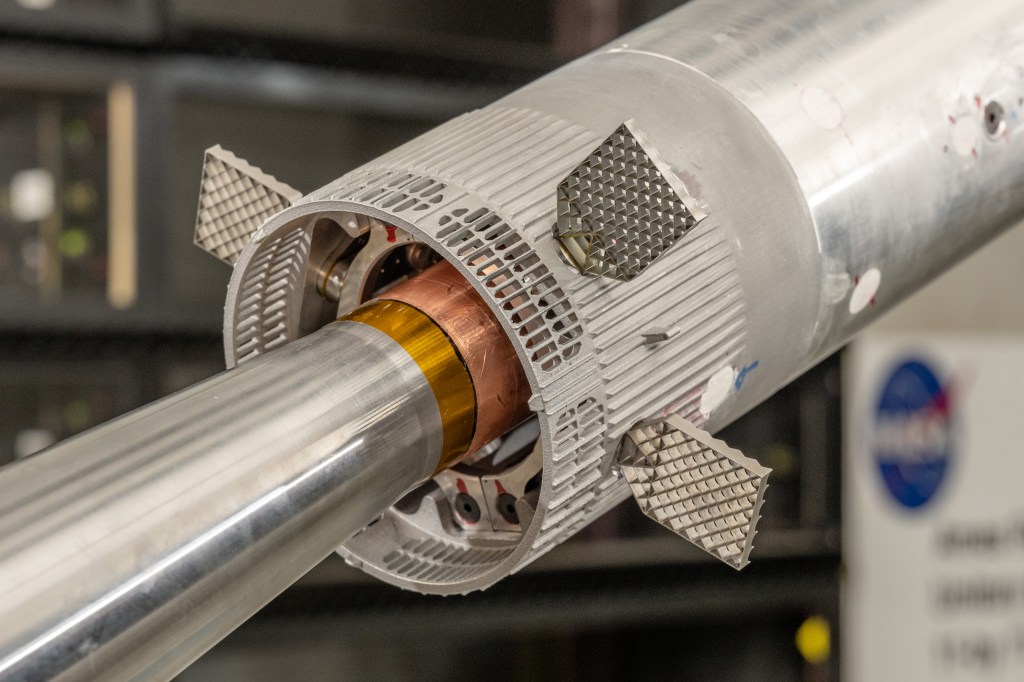
Posted on 08/15/2025 7:01:50 AM PDT by Red Badger
These fins are said to be among the largest aerodynamic control surfaces ever built for a rocket.

Grid fin for the next generation Super Heavy booster. SpaceX/X
Elon Musk’s SpaceX has redesigned some parts of its colossal Mars-bound Starship to improve its stability and control.
The most notable change is the removal of a landing fin from the Super Heavy booster, which will now use three redesigned grid fins that are 50% larger and stronger to improve vehicle control during descent.
The announcement was made on Wednesday via a post on X, where SpaceX shared images revealing the complex, honeycomb-like surface of the new grid fins.
The first grid fin for the next generation Super Heavy booster. The redesigned grid fins are 50% larger and higher strength, moving from four fins to three for vehicle control while enabling the booster to descend at higher angles of attack. pic.twitter.com/Nc6bavBHD8
— SpaceX (@SpaceX) August 13, 2025
Interestingly, these fins are said to be among the largest aerodynamic control surfaces ever built for a rocket.
Weighing in on the redesign, SpaceX CEO Musk shared the company’s announcement on X, adding a characteristically concise comment: “Best part is no part.”
Reports cite the development in the wake of recent test flight failures.
Improving descent and catch
To control the rocket’s position and flight path during descent and re-entry, grid fins manipulate the air passing through them.
With their larger surface area and increased strength, the new grid fins will give the booster greater maneuverability to descend at a steeper, more controlled angle during the landing phase.
The new fins are also being integrated into the booster’s recovery system.
These redesigned parts will align with the launch tower’s catch arms, which are designed to grab the descending booster out of the air.
SpaceX has added a new catch point to the booster and mounted the fins lower to align well with the tower’s arms. This change allows the tower to catch the returning rocket directly, eliminating the need for a landing pad.
Reportedly, the lower position of the fins also protects them from the intense heat of the rocket’s engines.
Moreover, the social media post mentioned that the fins’ internal parts, like the shaft, are now inside the booster’s main fuel tank for better protection.
VIDEO AT LINK.............
Previous failed attempts
The path to Mars hasn’t been smooth for SpaceX and its ambitious Starship program.
The redesign comes after the most recent failed test flight for the fully integrated rocket in May.
After the test flight, the Super Heavy booster failed to return to its launchpad and crashed into the Gulf of Mexico instead.
The main ship, meanwhile, continued its flight over the Indian Ocean before it too exploded.
In another incident in June, the rocket’s upper stage exploded while on a test stand during preparations for SpaceX’s tenth Starship flight.
The company is gearing up for its 10th orbital flight test, a critical demonstration of the new design.
Reportedly, the next Starship launch attempt could occur as early as Saturday, August 16, with a launch window between 6:30 am and 8:30 pm local time.
SpaceX typically keeps launch dates under wraps until closer to the time.
It is based on maritime hazard warnings from the US, which cover the waterways and sea areas around SpaceX’s Starbase facility in southern Texas.
“Navigation hazards from rocket launching activity may include, free-falling debris and/or descending vehicles or vehicle components, under various means of control,” the advisory noted, as the Independent reported.
Musk indicated in an X post earlier this month that SpaceX was aiming to launch Starship in mid-August.
The billionaire has set an ambitious goal to send the world’s largest rocket, with Tesla’s humanoid robot Optimus on board, to Mars by the end of 2026.
Given the recent failures and NASA’s budget cuts, the plan may be subject to further delays.
===============================================================
ABOUT THE AUTHOR Mrigakshi Dixit Mrigakshi is a science journalist who enjoys writing about space exploration, biology, and technological innovations. Her work has been featured in well-known publications including Nature India, Supercluster, The Weather Channel and Astronomy magazine. If you have pitches in mind, please do not hesitate to email her.
Wait till he finds out he's the cook, the dishwasher, the maid etc etc
All this expense to collect few martian rocks 😂
There is no air to breathe on mars, temps are extremely hostile to humans, and no water to grow crops.
The money will be much better spent on making planet earth a better place.
Bkmk
Optimus, Open the Starship airlock hatch ....
“I’m, sorry I can’t do that, Elon.”...................

It’s what humans do.
Ever since we left the savannas of Africa.....................
and I believe the soil is toxic
Think of it as a mitigation. If the earth took a hit from a serious comet, what would happen to humanity? Learning to populate and possibly eventually "terraform" Mars is one heck of a project. If Musk wants to spend his money that way, who's to argue? We all learn a lot along the way.
“All this expense to collect few martian rocks”
You have no idea ...
What is the driving idea between using a large number of small engines over a small number of large engines? Wouldn’t that increase the statistical number of failure points?
Thanks!
I couldn’t figure out what they were referring to.
re: the headline - I’m sure a DEI hire would’ve thought of that...
*eyeroll*
Yes, but smaller and less likely catastrophic failures...............
The money spent DOES make earth a better place. The money goes to scientists, engineers, suppliers, manufacturing companies, and so on. In the process of preparing for space, new materials, processes, techniques, and so on are developed and made available for mundane things.
Mars cannot be terraformed. It’s too small to hold an atmosphere. Even if we collected the entire asteroid belt and dragged Pluto to Mars, we would only increase its mass by about 5%, which is still too small.
The best we will be able to do is domed cities.
Venus is a better candidate, if we can figure out how to relieve the greenhouse effect.
The vanes on those airfoils are startling.
My first thought was ‘feathers’ or ‘scales’......................
That makes sense. It results in a smaller loss of thrust.
 This is all I can think of when envisioning living on mars
This is all I can think of when envisioning living on mars
Disclaimer: Opinions posted on Free Republic are those of the individual posters and do not necessarily represent the opinion of Free Republic or its management. All materials posted herein are protected by copyright law and the exemption for fair use of copyrighted works.